Physical Address
304 North Cardinal St.
Dorchester Center, MA 02124
Electron microscopy (EM) can assist in the identification of infectious organisms in surgical and clinical pathology specimens. However, since the advent of immunohistochemical, molecular (e.g., in situ hybridization, polymerase chain reaction), and serologic techniques, EM has been less often used to identify infectious pathogens. EM can still be useful, particularly in the identification of specific infections and the classification of novel organisms. In addition, EM is advantageous in situations in which most viral particles are present as empty virions devoid of nucleic acid. This chapter is not intended to be an exhaustive compendium of the EM characterization of all infectious diseases; rather, this chapter focuses on those infections in which EM plays a critical role ( Table 5.1 ).
| Pathogen | Approximate Size |
|---|---|
| Prion | 12-230 nm |
| Virus | 0.02-0.22 µm |
| Bacteria | |
| Staphylococcus aureus | 0.7 µm |
| Escherichia coli | 0.5 µm |
| Fungal Hyphae | |
| Histoplasma | 3 µm |
| Cryptococcus | 20 µm |
| Red blood cell | 7 µm |
| Parasite | |
| Worm eggs | 16-80 µm |
| Worms | ≥300 µm |
EM is best conducted on freshly fixed tissue. Surgical specimens (from biopsies or resections), cytology specimens, fecal samples in the case of gastrointestinal episodes, fluids or smears from skin lesions, cerebrospinal fluid, nasopharyngeal washes, saliva, tears, and urine are examples of samples that may be used for EM. In our laboratory, we typically use a modified Karnovsky fixative consisting of 2.0% glutaraldehyde, 2.5% formaldehyde, and 0.025% CaCl in a 0.1 M sodium cacodylate buffer pH 7.4. Fixation times vary with tissue type. Skin biopsies require long fixation times, sometimes longer than 3 hours, whereas cell suspensions or tissue-cultured cells can be adequately fixed in as little as 15 minutes. Postfixation with osmium tetroxide is necessary for good ultrastructural preservation because it preserves lipids that are typically lost in formalin-fixed, paraffin-embedded tissues. For a more comprehensive overview of our tissue processing method, see Table 5.2 . Sometimes tissue for conventional light microscopy that has been fixed in conventional buffered formaldehyde or paraffin-embedded tissue is the only material available. This tissue can also be used for EM, although significant artifact is typically present. Tissue remaining in buffered formaldehyde after fixation gives better results than tissue embedded in paraffin or tissue fixed in Bouin, Zenker, or B-5 fixative.
| Vial # | Contents | Time (min) | Temperature (°C) | Agitation? |
|---|---|---|---|---|
| 1 | Na cacodylate buffer | 5 | 10 | No |
| 2 | Na cacodylate buffer | 5 | 10 | No |
| 3 | 1.3% Osmium teroxide, aqueous | 90 | 10 | Yes |
| 4 | Na cacodylate buffer | 10 | 10 | No |
| 5 | 25% Ethanol (aq.) | 15 | 15 | No |
| 6 | 50% Ethanol (aq.) | 15 | 15 | No |
| 7 | 3% Uranyl acetate in 70% ethanol | 90 | RT | Yes |
| 8 | 95% Ethanol (aq.) | 15 | RT | No |
| 9 | 95% Ethanol (aq.) | 15 | RT | No |
| 10 | 100% Ethanol (absolute) | 15 | RT | No |
| 11 | 100% Ethanol (absolute) | 15 | RT | No |
| 12 | 100% Ethanol (absolute) | 15 | RT | No |
| 13 | Propylene oxide (100%) | 10 | RT | No |
| 14 | Propylene oxide (100%) | 10 | RT | No |
| 15 | PPO/epoxy resin (70/30) | 90 | 25 | Yes |
| 16 | PPO/epoxy resin (30/70) | 90 | 30 | Yes |
| 17 | Epoxy resin (100%) | 180 | 30 | Yes |
| 18 | Epoxy resin (100%) | 180 | 30 | Yes |
| 19 | Empty vial | — | — | — |
| 20 | Empty | — | — | — |
Although it is not routinely performed in our laboratory, rapid diagnosis of negatively stained viral particles by EM may be achieved within 10 minutes of receiving a sample. Negative staining methods usually use staining with a heavy metal aqueous salt solution, such as 2% uranyl acetate, 5% ammonium molybdate, or 1.0% potassium salt of phosphotungstic acid (PTA). Samples are dried onto thin-film carbon-coated grids, washed, stained, air-dried, and taken directly to the microscope. Viral inactivation is usually accomplished through drying and then irradiation with ultraviolet light. In our laboratory, we create agar cell blocks from samples otherwise too small to process. Briefly, in 5.0 mL Eppendorf tubes, samples (from fine-needle aspiration, bronchial lavage, urine, ascites fluid, or tiny tissue fragments) are fixed in standard fixative, centrifuged at 1000 rpm, resuspended in warm (liquid) 2% agar, and centrifuged again. The agar is then allowed to cool and harden. The centrifuge tube tip containing material is then cut off with a sharp razor blade, and the resulting tissue-containing agar block is processed routinely.
Transmission electron microscopy (TEM) is typically the technique used to examine surgical and clinical pathology specimens. With this technique, electrons are passed through samples and then imaged. Samples must be quite thin (80 to 100 nm) for the electrons to be able to pass through the specimen.
Most research related to diseases thought to be mediated by prions (small proteinaceous infectious particles) indicates that prions are protease-resistant proteins that do not contain nucleic acid. Prions are difficult to isolate and too small to be visualized by standard EM techniques. Typically, only vacuolated nervous tissue and reactive astrocytosis are seen histologically, and EM shows vacuoles in neurons and neuropils, as well as altered plasma membranes.
Recent research has focused on using immunologic methods, such as prion protein (PrP) immunohistochemistry and cryo-immunogold EM, to identify prions. It is hoped that such techniques will yield insights into disorders in which prions are considered to be critical, such as Creutzfeldt-Jakob disease and Gerstmann-Sträussler syndrome in humans and bovine spongiform encephalopathy (BSE) in cattle—and even other neurodegenerative disorders, such as Alzheimer, Parkinson, and Huntington diseases.
Viruses can be recognized as organized structures ( Fig. 5.1 ) smaller than cells and may be intracellular or extracellular, ranging from 20 to 300 nm in diameter. Viruses typically have one or more layers surrounding an electron-dense core consisting of DNA or RNA, referred to as the nucleoid ( Table 5.3 ), and are surrounded by a single or multilayer outer coating or shell, the capsid.
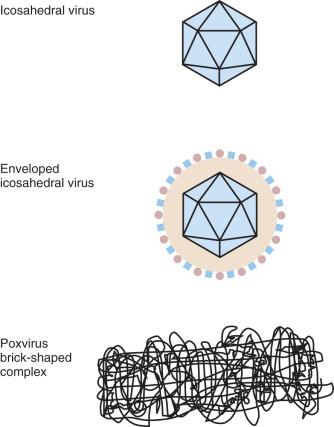
| Virus Family | Size * (nm) | Nucleic Acid Material | Shape |
|---|---|---|---|
| Parvoviridae | 18-26 | Naked ss DNA | Icosahedral |
| Hepadnaviridae | 22-27 | Enveloped ds circular DNA | Icosahedral |
| Papovaviridae | 45-55 | Naked ds circular DNA | Icosahedral |
| Adenoviridae | 80-110 | Naked ds DNA | Icosahedral |
| Herpesviridae | 150-200 | Enveloped ds circular DNA | Icosahedral |
| Poxviridae | 140-260 × 220-450 | Coated ds DNA | Complex |
| Picornaviridae, Astroviridae, Caliciviridae | 27-38 | Naked ss RNA | Icosahedral |
| Reoviridae | 60-80 | Naked ds segmented RNA | Icosahedral |
| Togaviridae | 50-70 | Enveloped ss RNA | Icosahedral |
| Flaviviridae | 45-60 | Enveloped ss RNA | Complex |
| Arenaviridae | 50-300 | Enveloped ss segmented RNA | Complex |
| Coronaviridae | 80-220 | Enveloped ss RNA | Complex |
| Retroviridae | 80-100 | Enveloped ss diploid RNA | Complex |
| Bunyaviridae, Orthomyxoviridae | 80-120 | Enveloped ss segmented RNA | Helical |
| Paramyxoviridae | 150-300 | Enveloped ss RNA | Helical |
| Rhabdoviridae | 60-80 × 130-220 | Enveloped ss RNA | Helical, bullet-shaped |
| Filoviridae | 80 × 1,000 | Enveloped ss RNA | Helical |
Size, shape, and organization of virions are useful characteristics in identifying viruses. Sizes range from small (e.g., papovaviruses) to intermediate (e.g., adenoviruses, herpesviruses) to large (e.g., poxviruses). Virions may be organized into latticelike arrangements (e.g., adenoviruses), which vary from regular to random (e.g., papovavirus). Because of these characteristic differences, EM can be quite helpful in characterizing viruses. Although the morphology and size are useful in identifying viruses, there is overlap, and complementary techniques to EM are often needed, including immunohistochemistry, in situ hybridization, Southern blot analysis, and polymerase chain reaction for viral DNA.
Herpesvirus virions ( Figs. 5.2 and 5.3 ) are surrounded by limiting lipid bilayers, giving the virions a “fried egg” look. The envelopes serve both a functional and a structural role. The virions have a hexagonal outline (icosahedral morphology) and are covered with 152 tubular capsomeres. The complete herpes viral structure with envelope is 150 to 180 nm in diameter, and the internal portion of all herpes group viruses is approximately 100 nm in diameter. Viral inclusion bodies of herpesvirus are composed of lattice arrangements of mature viral particles (virions). Other members of the herpesvirus family (i.e., herpes simplex, cytomegalovirus, and Epstein-Barr virus) have a similar appearance, and all are 100 to 120 nm in size. They all replicate in the nucleus of the host cell.
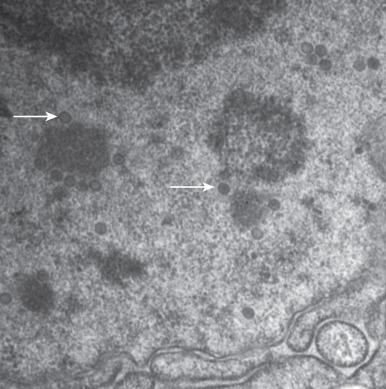
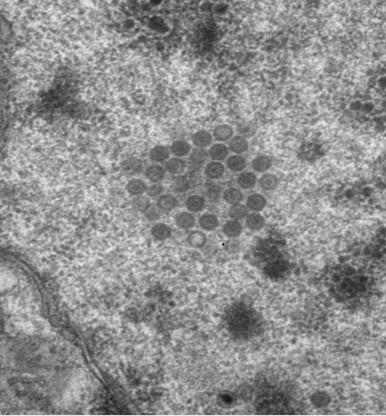
Varicella virus, the causative agent of chickenpox (also known as human herpesvirus 3) is usually a benign disease of childhood. Ultrastructurally ( Fig. 5.4 ), viral nucleocapsids can be identified in the nucleus and budding through the nuclear envelope. Virions may be present in cytoplasmic vacuoles and are sometimes abundant. Herpes zoster (shingles) is a reinfection of the varicella virus that commonly manifests in the skin, often as vesicular eruptions in a dermatomal distribution along sensory nerves. Virus is produced in lower quantities than in the primary chickenpox infection.
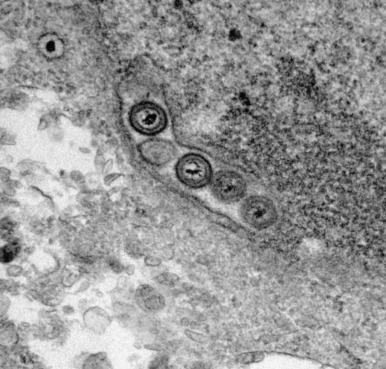
Adenovirus ( Figs. 5.5 and 5.6 ) commonly infects the respiratory and enteric tracts. Rarely, the liver and pancreas may be involved. Adenovirus is contained as numerous packets of virions in a paracrystalline array, often in the nucleus of cells when newly synthesized and sometimes in the nucleolus as an inclusion body. In early infection, incoming virus is seen in the cytoplasm. Individual virions have a hexagonal (icosahedral) shape with 20 sides and 12 vertices. Surrounding the core of the virus are 252 pentagonal capsomeres, each with a filamentous projection (fiber). Cells may become large (cytomegaly) with large eosinophilic inclusions appreciable by light microscopy. Granular aggregates in the nuclei of cells infected by adenovirus are made up of various viral-induced proteins.
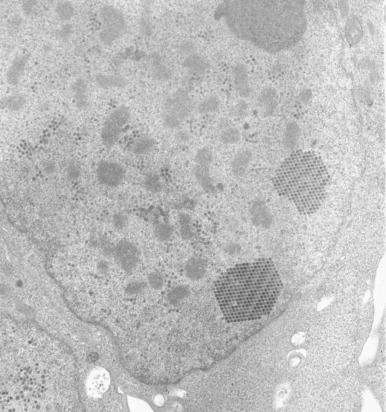
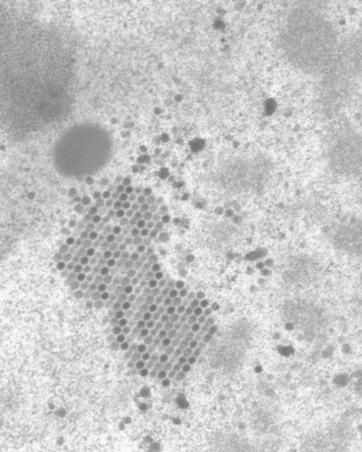
Influenza virus ( Figs. 5.7 and 5.8 ), an orthomyxovirus, is a pleomorphic virus consisting of round-to-spherical, kidney-shaped, or elongated virions located at and beneath the cell surface. Virions are 80 to 120 nm in diameter, and filamentous forms may be several micrometers in length. Viruses typically enter respiratory tract epithelium by attaching to and fusing with the cell membrane, mediated by hemagglutinin binding to sialic acid residues in a ligand-receptor interaction. Hemagglutinin and neuraminidase spikes project 8 to 10 nm from the viral envelope, and the nucleocapsid, 9 to 15 nm in diameter, has helical symmetry. Infected cells may have an increased density of nucleoli during active protein synthesis. Hemagglutinin proteins form in the cytoplasm and may be present in excess as long fibers. Dense protein lattices surrounded by small dense ribosomes are present. Virions emerge by budding from the host cell plasma membrane.
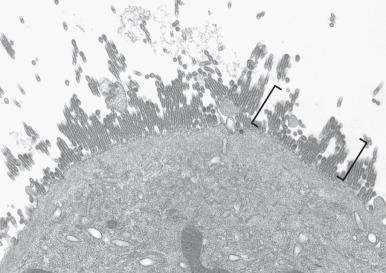
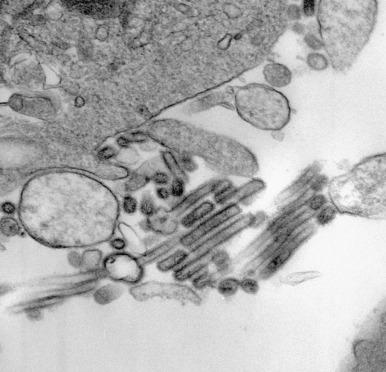
Members of the Paramyxoviridae family measure 120 to 300 nm in size. There are many members of Paramyxoviridae , including mumps, parainfluenza ( Figs. 5.9 and 5.10 ), Morbillivirus species (including measles), and Pneumovirus species (including respiratory syncytial virus). One common place to identify paramyxovirus is in type II pneumocytes, which may be multinucleated and may have a ground-glass appearance. The virions are diffusely dispersed in the cell and have a filamentous protein nucleocapsid protecting the viral nuclei acid, giving the virus a “herringbone” appearance.
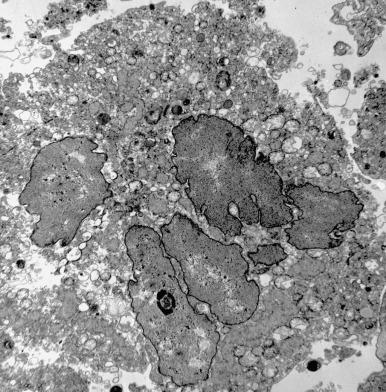
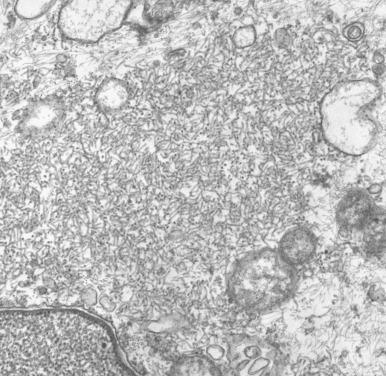
Variola virus, the agent of smallpox, is often recognized from material collected from skin lesions. The slightly rounded, brick-shaped virions measure approximately 270 by 350 nm. The organisms have a complex surface structure and may be recognized in one of two types: a mulberry form with 10- to 20-nm diameter and a beaded short-tubular surface and a capsular form with a 30-nm membrane.
Hepatitis A virus (enterovirus 72) is a member of the picornavirus family, 24 to 30 nm in diameter, and roughly spherical. Cytopathic effect leads to an increase in intracellular ribosomes and large polyribosomes.
Hepatitis B virus, a hepadnavirus ( Figs. 5.11 and 5.12 ), is 22 to 27 nm in diameter and consists of a central core of double-stranded DNA with nucleocapsid DNA. An envelope containing the hepatitis B surface antigen (HBsAg) is 7 nm wide and contains a 27-nm diameter central core, also referred to as the Dane particle, which contains the hepatitis B core antigen (HBcAg) and e antigen (HBeAg). The viral particles may form spherules and tubules.
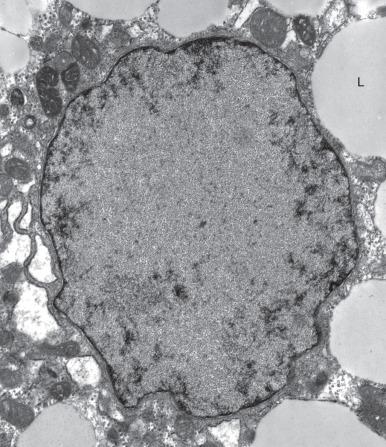
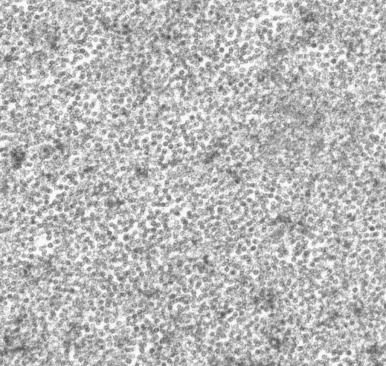
Parvovirus B19 is a small, round, nonenveloped icosahedral virus, 18 to 26 nm in diameter, without distinctive surface features. They may be confused with ribosomes. At high magnification, they have a roughly hexagonal outline. Virus is assembled in the nucleus and appears either “empty” or “full.” It may be recognized in blood serum by EM.
Become a Clinical Tree membership for Full access and enjoy Unlimited articles
If you are a member. Log in here